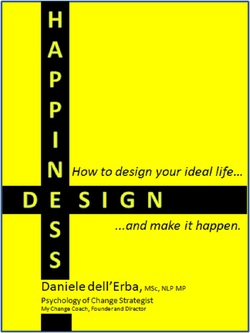
The book is about happiness. More specifically it’s about designing happiness. In other words it’s about learning how to define, clarify, plan and realize your very own set of conditions that, when fulfilled, make you feel happy.
In the book I include step by step instructions on how to figure out what is important to you and leverage that knowledge to generate life plan options, pick the best and make it happen.
I introduce practical tools and techniques from the field of applied psychology including Neuro-Linguistic Programming, Cognitive Behavioural Therapy, Interpersonal Communications, TimeLine Therapy as well as more practical considerations coming from the field of change management and project planning.
I wrote this book the way I live my life: with passion. I hope it will inspire you to take your life’s design in your own hands and to live your ideal life on your own terms.
You can get it for free on Amazon only from Wednesday 22nd of January to Saturday 25th of January and again on Thursday February 13th via this link: http://www.amazon.com/dp/B00HVI3VQO
After this promotion it will be available for purchase any time via the same link.
If you go for the free download option I would appreciate your constructive reviews to help position it on amazon.com.
Feel free to share the book with those you care about.
Wishes of a happy and productive 2014!









 RSS Feed
RSS Feed
